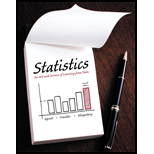
Concept explainers
Benford’s Law When looking at a collection of numbers, such as population sizes, the figures on tax returns or the charges on a credit card, one may think that the leading digit of the number is equally likely to be any of the numbers from 1 to 9. However, such data sets often show a distribution for the leading digit that is quite different from uniform and is described by Benford’s Law. This law stipulates that the

- a. Find the expected counts, assuming the leading digits for the transactions follow Benford’s Law.
- b. Is there evidence that the distribution of the leading digit does not follow Benford’s Law? Write a conclusion based on an appropriate test. If available, use software to read in the raw data and compute the test statistic and P-value.
Want to see the full answer?
Check out a sample textbook solution
Chapter 11 Solutions
Statistics: The Art and Science of Learning from Data (4th Edition)
 Glencoe Algebra 1, Student Edition, 9780079039897...AlgebraISBN:9780079039897Author:CarterPublisher:McGraw Hill
Glencoe Algebra 1, Student Edition, 9780079039897...AlgebraISBN:9780079039897Author:CarterPublisher:McGraw Hill Holt Mcdougal Larson Pre-algebra: Student Edition...AlgebraISBN:9780547587776Author:HOLT MCDOUGALPublisher:HOLT MCDOUGAL
Holt Mcdougal Larson Pre-algebra: Student Edition...AlgebraISBN:9780547587776Author:HOLT MCDOUGALPublisher:HOLT MCDOUGAL


